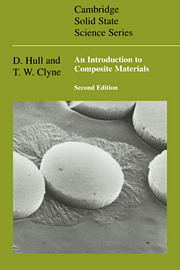Book contents
- Frontmatter
- Contents
- From the preface to First Edition
- Preface to Second Edition
- 1 General introduction
- 2 Fibres and matrices
- 3 Fibre architecture
- 4 Elastic deformation of long-fibre composites
- 5 Elastic deformation of laminates
- 6 Stresses and strains in short-fibre composites
- 7 The interface region
- 8 Strength of composites
- 9 Toughness of composites
- 10 Thermal behaviour of composites
- 11 Fabrication
- 12 Applications
- Appendix: Nomenclature
- Author index
- Subject index
2 - Fibres and matrices
Published online by Cambridge University Press: 05 June 2012
- Frontmatter
- Contents
- From the preface to First Edition
- Preface to Second Edition
- 1 General introduction
- 2 Fibres and matrices
- 3 Fibre architecture
- 4 Elastic deformation of long-fibre composites
- 5 Elastic deformation of laminates
- 6 Stresses and strains in short-fibre composites
- 7 The interface region
- 8 Strength of composites
- 9 Toughness of composites
- 10 Thermal behaviour of composites
- 11 Fabrication
- 12 Applications
- Appendix: Nomenclature
- Author index
- Subject index
Summary
In this chapter, the underlying science of fibres and matrices is described. Some specific examples are given to illustrate the key factors involved. A wide range of reinforcements, mostly in the form of fibres, is now available commercially. Their properties can be related directly to the atomic arrangement and the defect content of the reinforcement, which must be controlled in the manufacturing processes. Matrices may be based on polymers, metals or ceramics. The choice of matrix is related to the required properties, the intended applications of the composite and the method of manufacture. The properties of the matrix depend on microstructure which, in turn, depends on manufacturing route and subsequent thermal and mechanical treatments. Certain properties of the composite may be sensitive to the nature of the reinforcementi/matrix interface; this topic is covered in detail in Chapter 7.
Reinforcements
Many reinforcements are now available, some designed for a particular matrix system. A selection is listed in Table 2.1. Typical properties of fibres are given in Table 2.2. All have high stiffness and relatively low density. Carbon, glass and aramid fibres are now used extensively in polymer matrix composites. Carbon fibres are also important for carbon/ carbon composites. Ceramic fibres, whiskers and particles can be used to reinforce metal and ceramic matrices.
Information
- Type
- Chapter
- Information
- An Introduction to Composite Materials , pp. 9 - 38Publisher: Cambridge University PressPrint publication year: 1996
Accessibility standard: Unknown
Why this information is here
This section outlines the accessibility features of this content - including support for screen readers, full keyboard navigation and high-contrast display options. This may not be relevant for you.Accessibility Information
- 3
- Cited by
